
|
|
Für die deutsche Fassung bitte nach unten scrollen
|
|
|
|
A Colorful Dance into Autumn with
Ancient Art
|
Following a successful summer art fair at the Salzburger Festspiele, where we were able to welcome again many international visitors, we have started our preparations for the upcoming major autumn events. Firstly, we will exhibit as the sole gallery for ancient art at ART AUSTRIA Highlights from 6 to 9 October in Vienna. And shortly afterwards, on Thursday October 13th we open our grand autumn exhibtion in our showroom in Vienna. Details and invitations will of course follow. Just as a preview: The gods will be strongly represented in their figurative splendor like Mars and graceful beauty like Isis-Aphrodite.
|
|
|
|
Our Highlight of the Month:
|
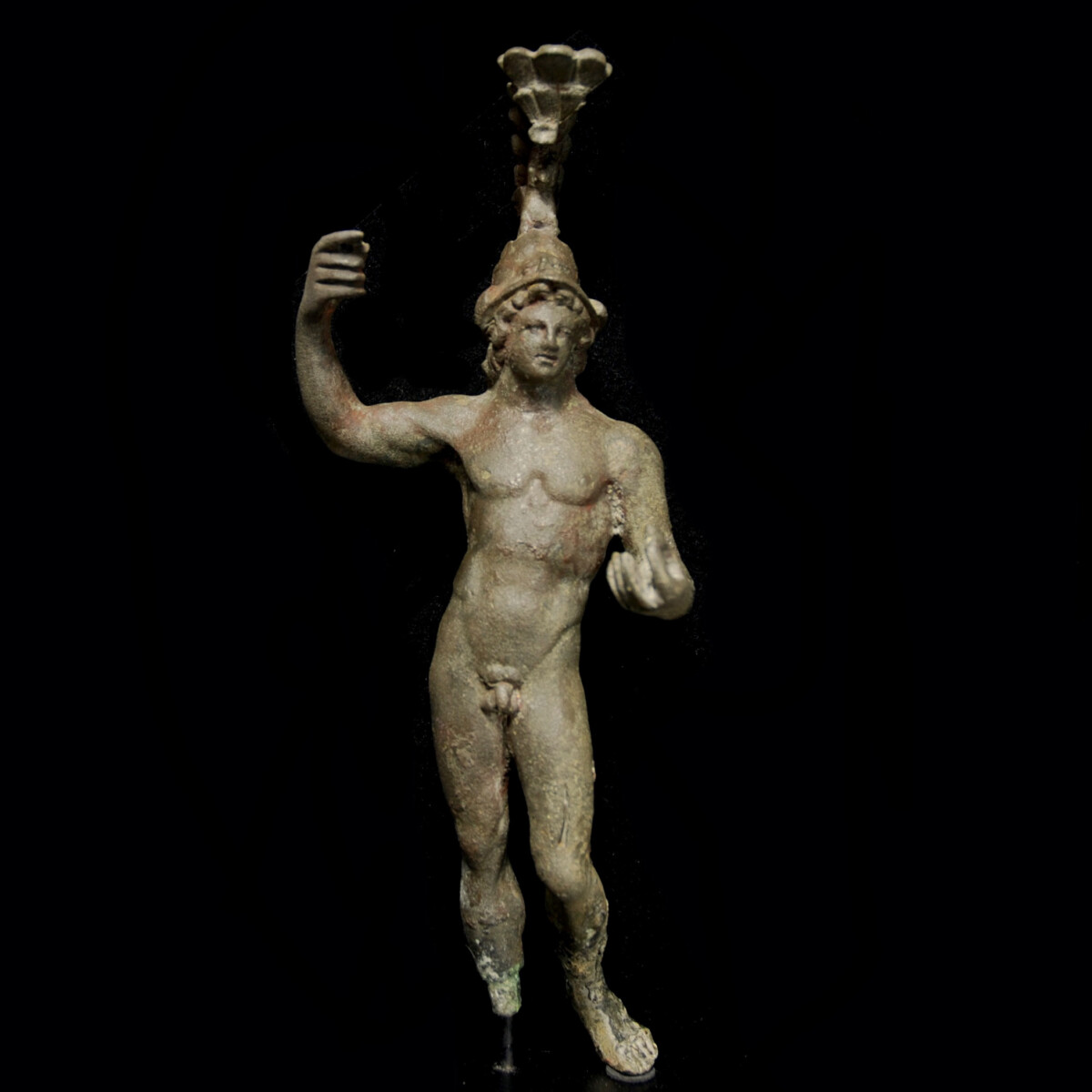
|
|
|
|
|
|
|
|
Roman Empire – 2nd century A.D.
|
Large and important solid bronze statuette of Mars. The god of war stands without clothes with his weight on the right leg, the left free leg is slightly bent backwards. He wears a Italo-Corinthian helmet with a high crest which is supported by a griffin and ends with a volute. The cheek guard is pulled up, the thick, semi-long hair protruding under the helmet. The heroic features and the curls parted in the centre are still in the tradition of Alexander the Great. In his right, raised hand he once held a separately worked out spear, which is missing today. In his left forward bent hand he once held a sword placed on his lower arm. Nipples and lips are with copper inlays, the eyes possibly with silver. See for the type the Roman bronze statuette of Mars in the Louvre with the inventory number Br1045. Mounted.
|
Provenance: From the private collection of the French archaeologist Louis-Gabriel Bellon (1819-1899). For over 120 year in a family estate.
Dimensions: 21.5 cm high
Price: 32 000 Euro
|
|
|
|
Selected Artworks of the Month:
|
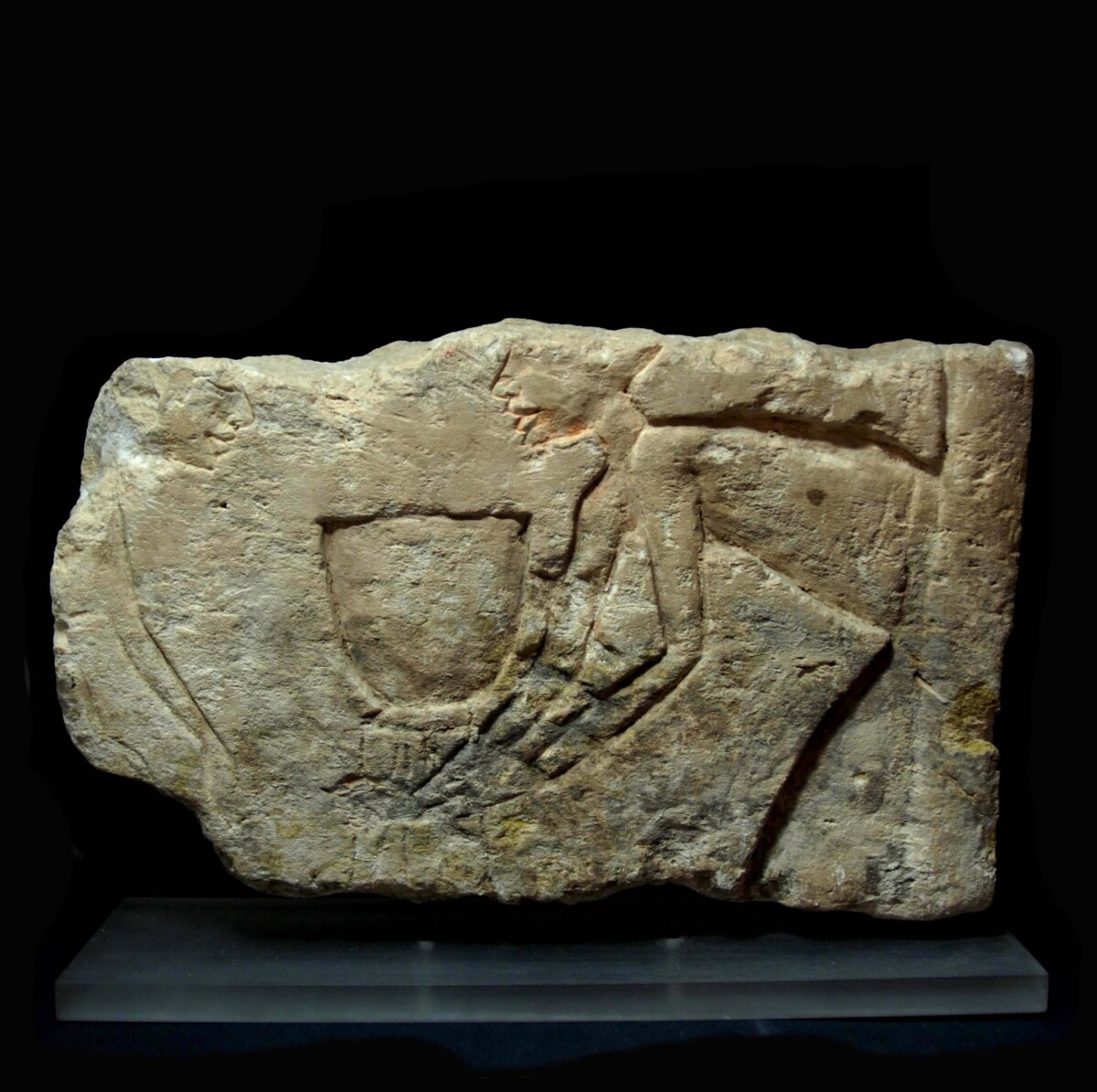
|
|
Egypt – 18th dynasty, Amarna period, 1351-1334 B.C.
|
Large limestone fragment from the Amarna period under the reign of Pharaoh Akhenaten. Depicted are two male figures bending towards each other. The man on the right wears a long, straight kilt and supports a large vase with his overlong arms on a tripod. The figure on the left also stretches its long arms towards the vase. It is likely that the right-hand man (Akhenaten himself?) is shown leaving a building, according to a model also documented in the royal tomb at El-Amarna. On this assumption compare G. Thorndike Martin, "The Royal Tomb at El-'Amarna", London, 1989, plate 34. The faces with the elliptical eyes, the prominent noses and chins are as typical of the art of the Amarna period as are the overlong, slender arms and limbs. socketed.
|
Provenance: New York private collection S. Carroll, acquired 1969. Thence Bonhams London on 28 November 2017, lot 16.
Dimensions: 23.5 cm x 38 cm
Price: 28 000 Euro
|
|
|
|
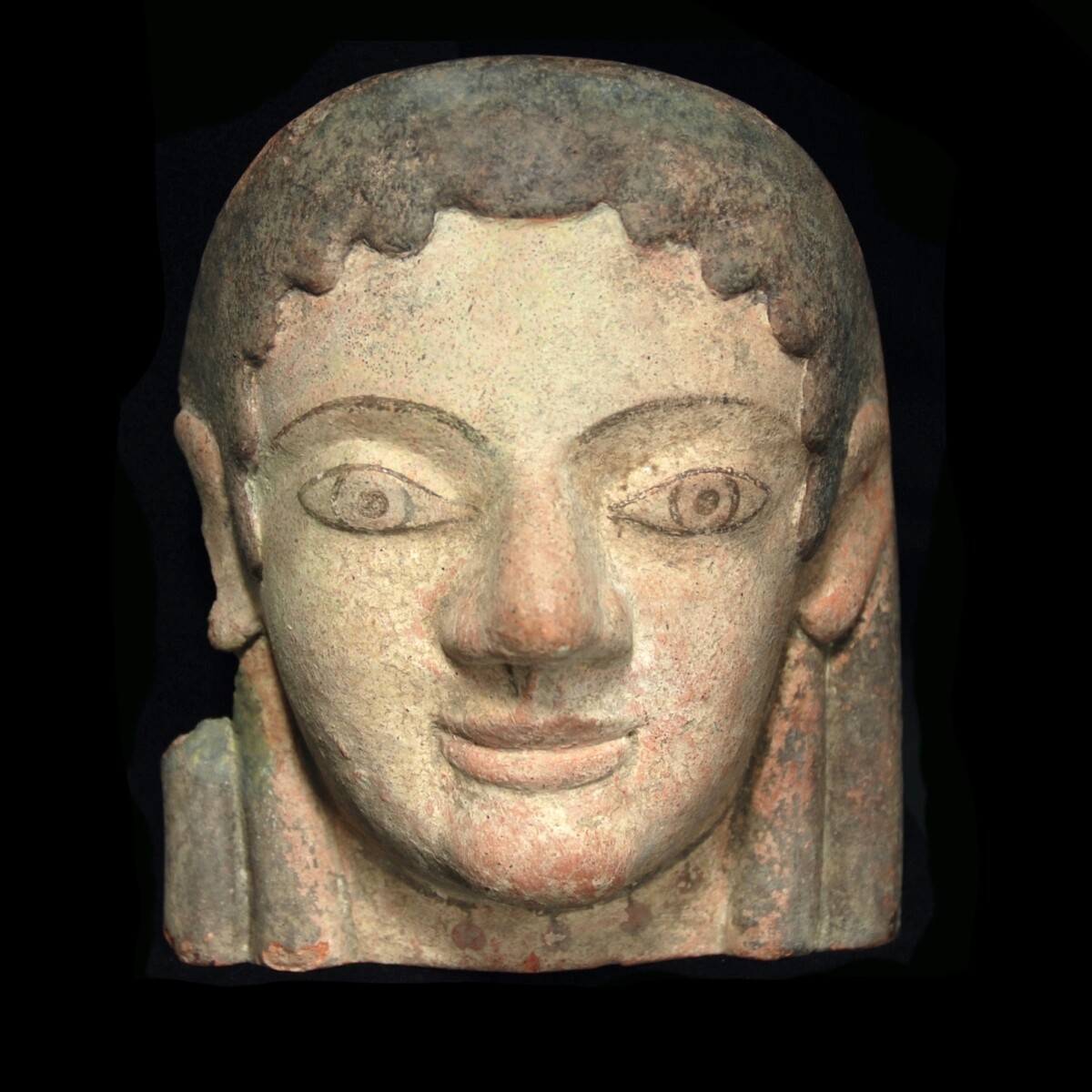
|
|
|
|
|
Wonderfully preserved terracotta antefix in form of an archaic female head with beautifully preserved paint. The large, almond-shaped eyes with round painted pupils and above diligently drawn brows. The mouth is formed to the typical smile, the nose is relatively large and long. The black painted hair cascades in regular waves into the forehead, a longer strand falls in front of each ear, two more thick strands fall on the sides over the neck. The woman wears a necklace with red and black beads. Still preserved behind the head are large parts of the long extension, which was used to attach the antefix to the eave. Possibly from Cerveteri, ancient Caere.
|
Provenance: According to reports English private collection prior to 1970. Thence US private collection, acquired from Faustus Ancient Art Ltd. in London in 1988. Thence Royal Athena gallery New York, published in "Art oft the Ancient World”, Volume XXII, 2011, number 93. Last in the private collection Sigrid Fiebig, Bad Herrenalb, Germany, acquired on 3 April 2016 in an Austrian gallery. With original invoice and certificate from 2016.
Dimensions: 17 cm high; 28.4 cm long
Price: 12 000 Euro
|
|
|
|
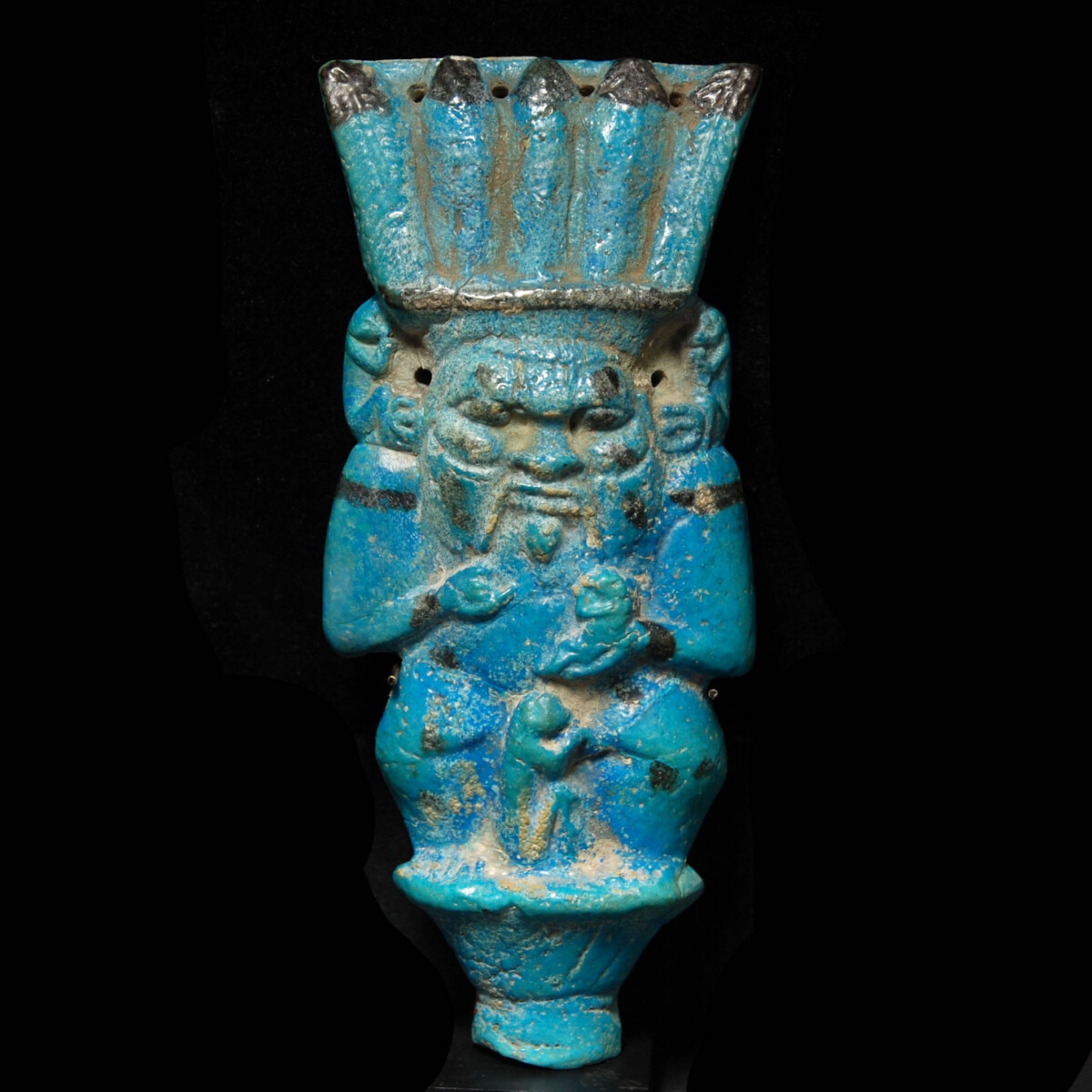
|
|
Egypt – Third Intermediate period, 1069-945 B.C.
|
Large statuette of the dwarf-like tutelary god Bes made of blue glazed faience. Bes acts in his function as the protector and nourisher, as the almighty Lord of the fate of mothers and children. He crouches on a papyrus column and wears a high crown with five feathers arising from his basket-like headdress, a kalathos. The ends of the feathers are painted in black. On the sides of his head and the protruding ears two crouching monkeys, which hold their front paws to their eating mouth. The god lovingly holds another young monkey in his left hand while passing some fruit with his right hand. A fourth young monkey sits straight and is also eating between the short, strong legs of Bes. The distinctive face of the tutelary deity is typically grotesque, with a shaggy beard and open mouth with visible rows of teeth and the tongue sticking out. The entire figure is decorated on the front and back with black lines and dots. Perforations at the end of the feather crown and above the ears indicate that the statuette was in addition decorated with a precious metal. A ribbed eyelet on the back served for suspension, possibly on a bed or in a room of a mother or her children. The bottom is also pierced so the figure could also be mounted. Found in the eastern Delta. Published in "La Collection Emmacha. Antiquités Égyptiennes", Livre 2, Paris 2013, pages 217-218. See for the type the figure in the Penn Museum with the object number E14358. Mounted.
|
Provenance: Swiss art market prior to 1983. Thence Sotheby’s New York on 8 June 1994, lot 10. From there acquired by the collection S., Paris, France. Thence collection Emmacha Paris prior to 2013. With a copy of the publication of the statuette in the catalogue of the Emmacha collection of 2013. Accompanied by a French antiquities passport.
Dimensions: 17.4 cm high
|
|
|
|
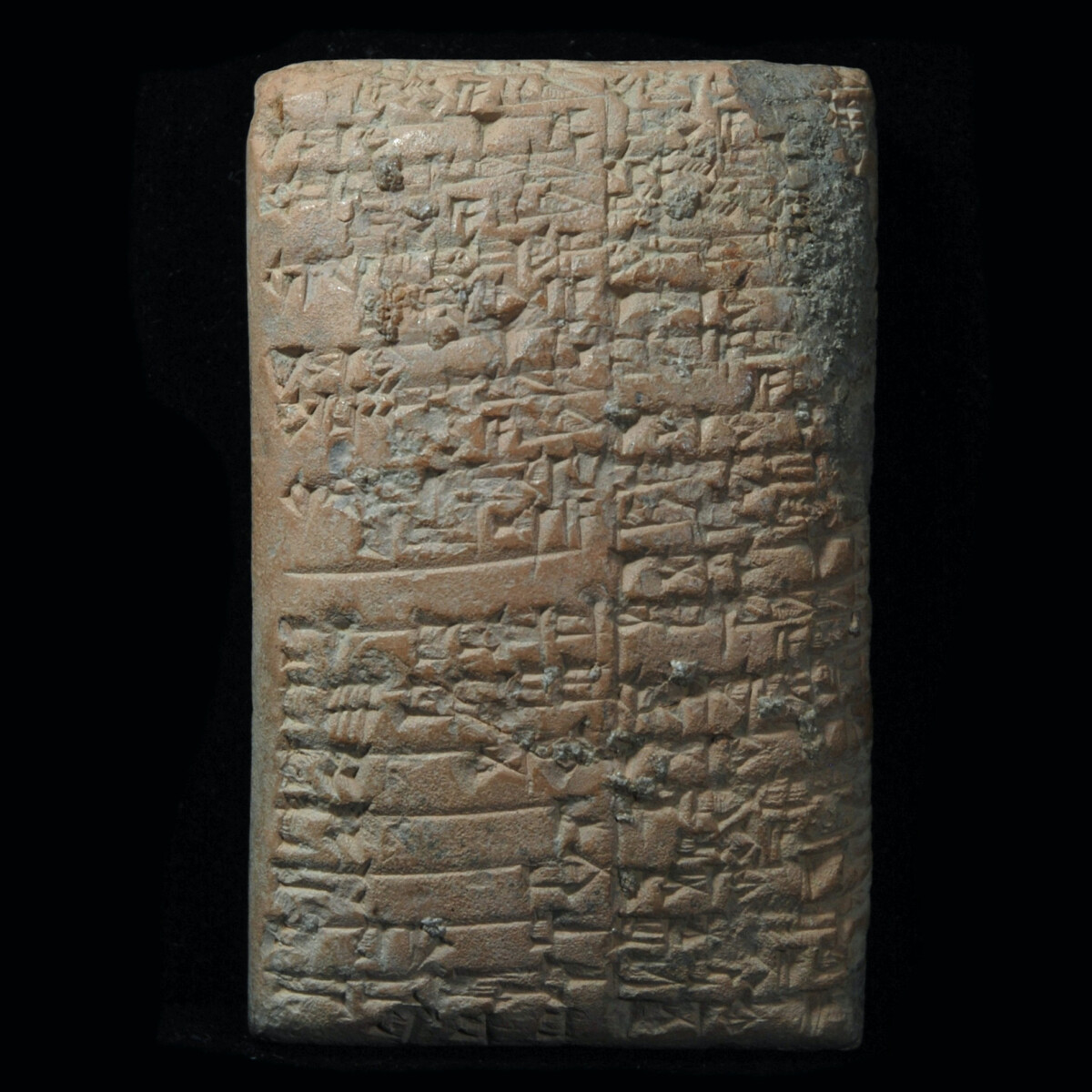
|
|
|
|
|
|
Sumer – Ur-III-period, 2112-2004 B.C.
|
Large Sumerian cuneiform tablet which is tightly and meticulously inscribed on both sides. The tablet, flat on one side, on the other side convex, belongs to the so-called messenger texts. These text tablets mention the names of the messengers who travelled between Mesopotamia and Iran, and specifically listed which food and beverages were handed over at the stations along the way. The messengers received, according to their ranks, a certain amount of litres of beer and bread, oil as well as onions. A messenger of noble rank who travelled under a diplomatic mission received a multiple of proviant than a regular messenger. See for the messenger texts the collection in the Kelsey Museum of Archaeology at the University of Michigan, USA. See: Nicole Brisch “A Sumerian Messenger Text in the Kelsey Museum”, volume 15, 2003. Most of these cuneiform tablets, like the present one, originate from the cities Girsu and Umma, both in the south of present Iraq and along the travel route to Iran. Our cuneiform tablet with the messenger text is relatively large and lists numerous names. Unpublished until today.
|
Provenance: From the collection of the British professor Geoffrey Wilson (1930-2015), acquired in the 1960s. Thence in a London gallery. Last in the collection of Dr D. G., acquired between 1990 and 2019.
Dimensions: 10 cm x 6.4 cm
|
|
|
|
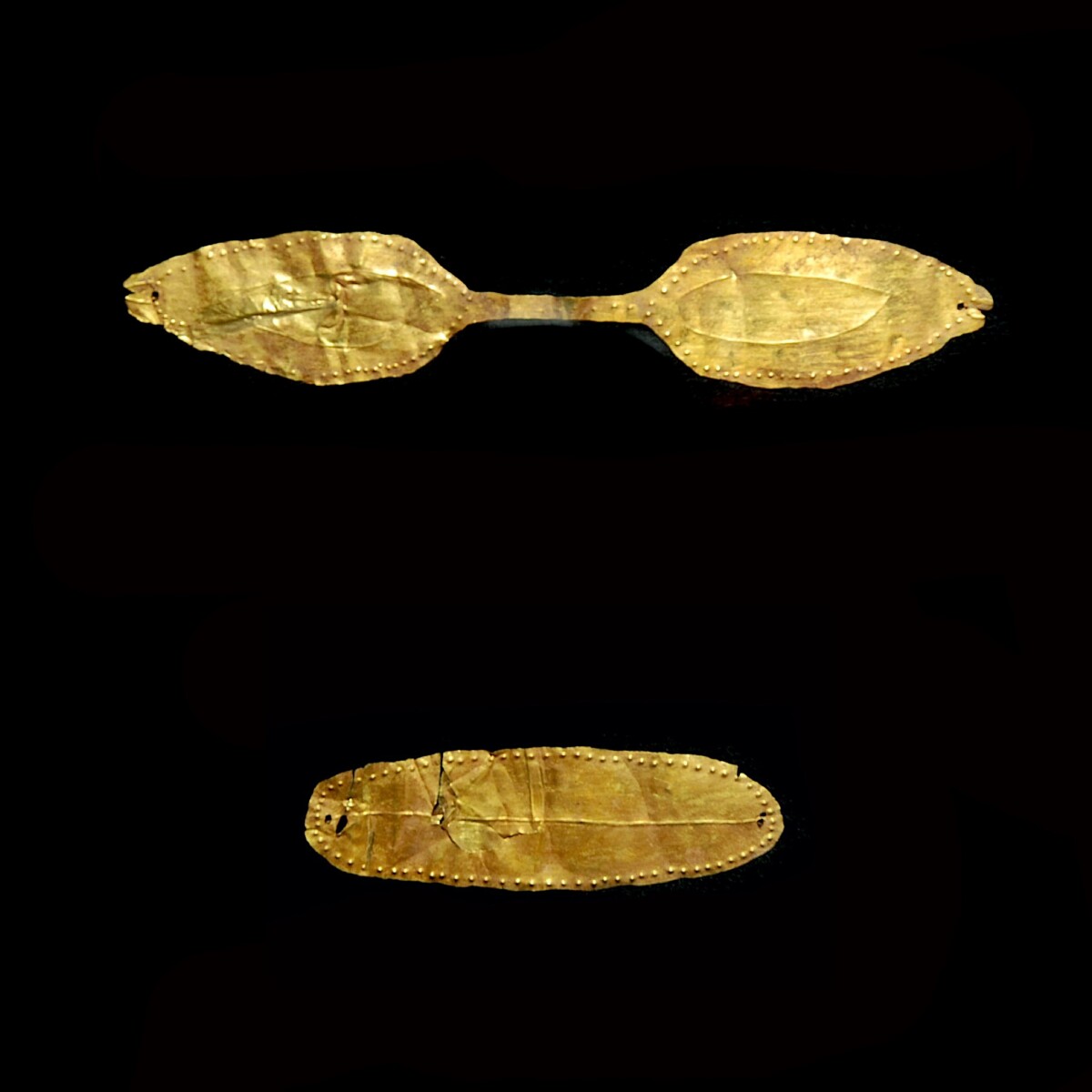
|
|
Greece – 7th-6th century B.C.
|
A belonging set of gold sheets which were placed on the eyes and mouth of a deceased, high-ranking warrior. The eyes of finely worked out gold sheet which are connected by a nose bracket. The large iris is almond-shaped, at the rim an encircling band of punched dots. The belonging mouth also of thin gold sheet and leaf shaped. The rim of punched dots. Across the centre a finely drawn line between the upper- and lower lip. Mounted in a black frame behind glass for suspension on a wall or for placing on some furniture.
|
Provenance: From the Bavarian collection M. W., acquired in the 1990s at Numismata in Munich, Germany.
Dimensions: 11.8 cm long (pair of eyes); 6.5 cm long (mouth); 25.5 cm x 25.5 cm (frame)
Price: 1 600 Euro
|
|
|
|
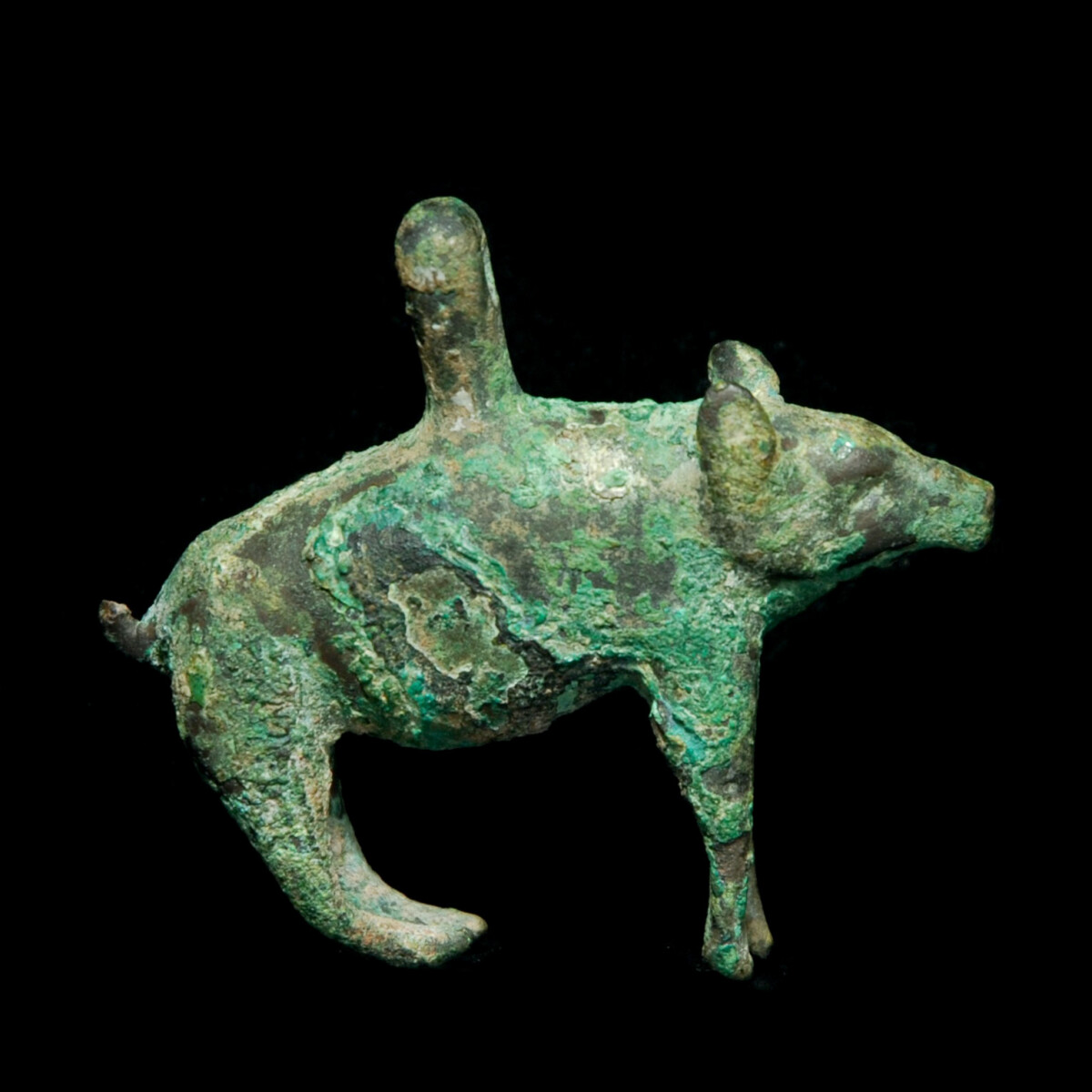
|
|
|
Large and heavy bronze statuette of a straight standing boar. The animal with straight forelegs and slightly bent hindlegs. The buttocks with the short, raised tail is pushed back. The massive body with a hanging belly. The head sits on the strong neck, the ears are raised, the trunk pointing forward. On the back of the animal a large eyelet for suspension. Due to the weight (103 gram) one can speculate that the boar did not serve as an amulet but rather as a weight.
|
Provenance: Private collection Robert Blanchet (1921-2009), acquired on 11 April 1997 from the gallery Jean Philippe Mariaud de Serres in Paris. Since then in a family estate. With an original collection card and the collector’s handwritten description, as well as the original certificate of the gallery de Serres.
Dimensions: 6,1 cm x 6,6 cm
Price: 4 400 Euro
|
|
|
|
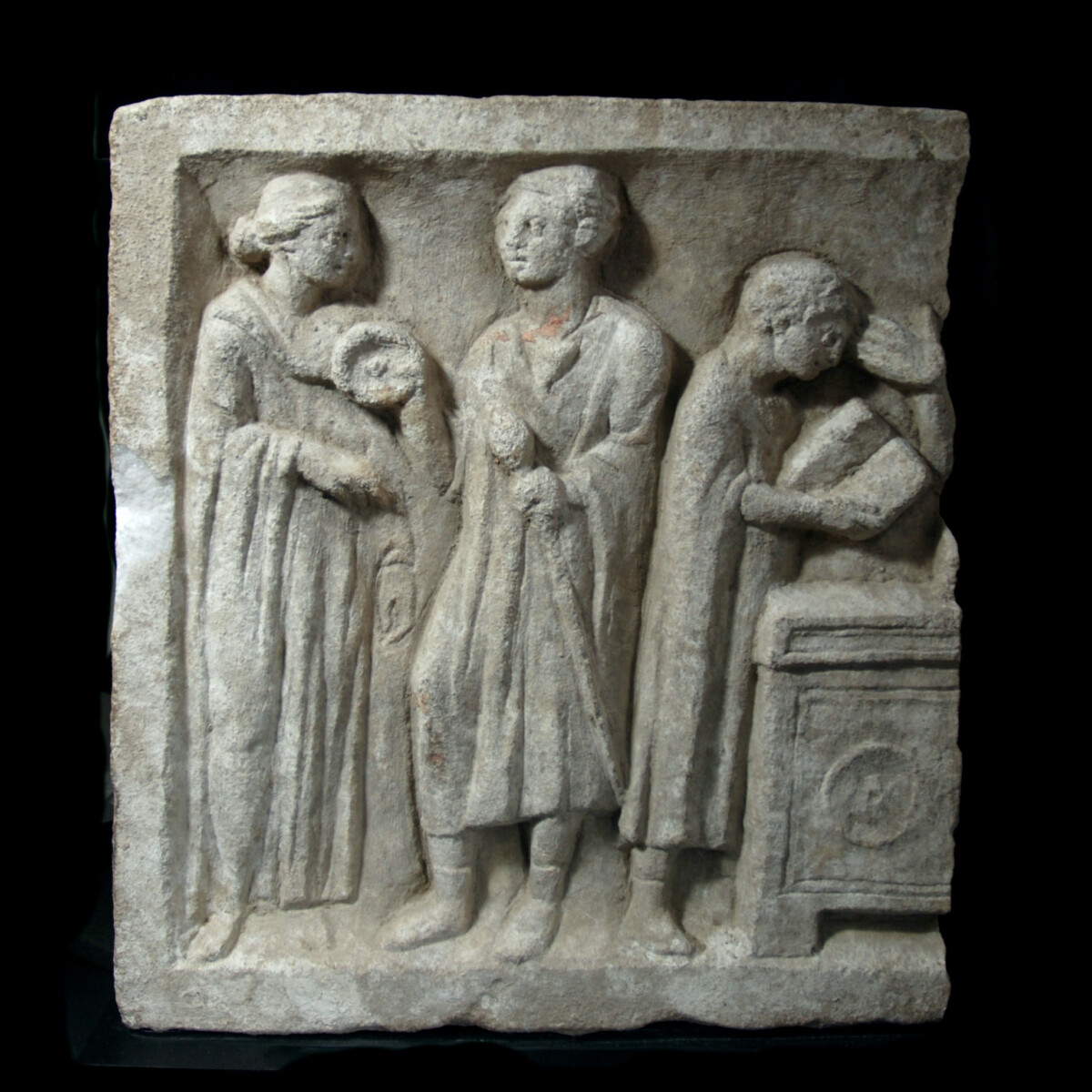
|
|
Greece – 2nd - 1st century B.C.
|
Left part of a marble votive stele depicting a funerary scene. Left a woman facing to the right. She wears a long gown and has a cape wrapped around her right arm. Her hair is parted in the middle and pulled back into a bun. Facing her is a man of high ranking with a civic staff. He holds in the right hand an offering bowl. To his right a youth turns to an offering table. In the hand he possibly holds a pyxis. The deceased is seated behind the table, the right hand reaching out towards the offering attendees iof the procession.
|
Provenance: Nicolas Koutoulakis (1910-1996), Paris and Geneva. Thence in a family estate.
Dimensions: 37 cm high
Price: 6 600 Euro
|
|
|
|
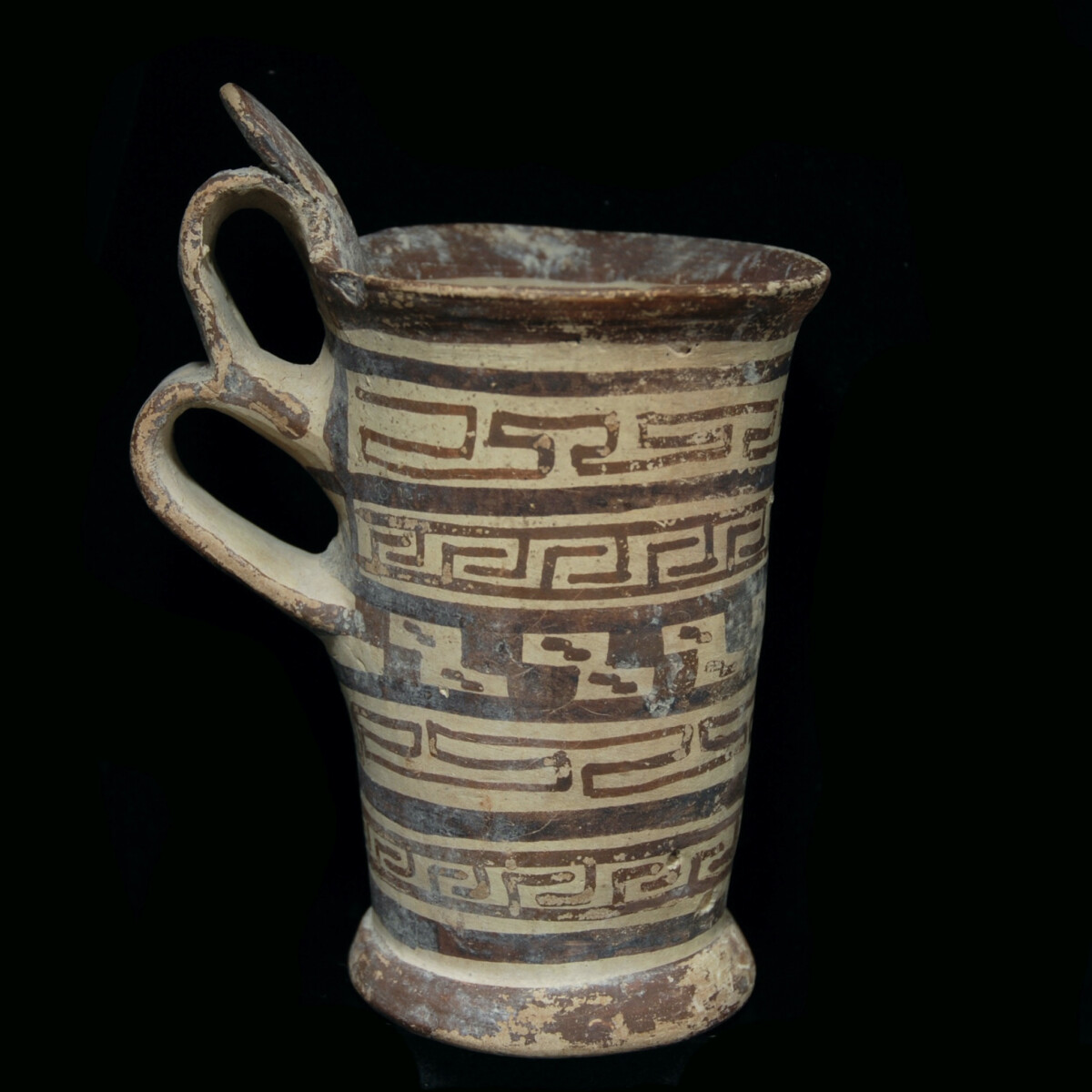
|
|
Greece/Southern Italy – around 700 B.C.
|
Wonderfully preserved terracotta tankard with a cylindrical corpus and a flat base. The rim is slightly pulled upwards and painted with a red-brown color. The entire corpus is decorated with encircling geometric ornaments in five registers. Below large meanders in different sizes, rectangles and wavy lines. Between the registers encircling, dark brown bands. Especially notable is the 8-shaped curved band handle with a thumb-rest. This thumb-rest is decorated with a stylized animal, possibly a bird. The outside of the band handle with painted arrows. From southern Italy. Rare in this form.
|
Provenance: American private collection, auctioned in an auction house in Chicago on 2 April 2003, lot 637.
Dimensions: 14 cm high
Price: 1 800 Euro
|
|
|
|
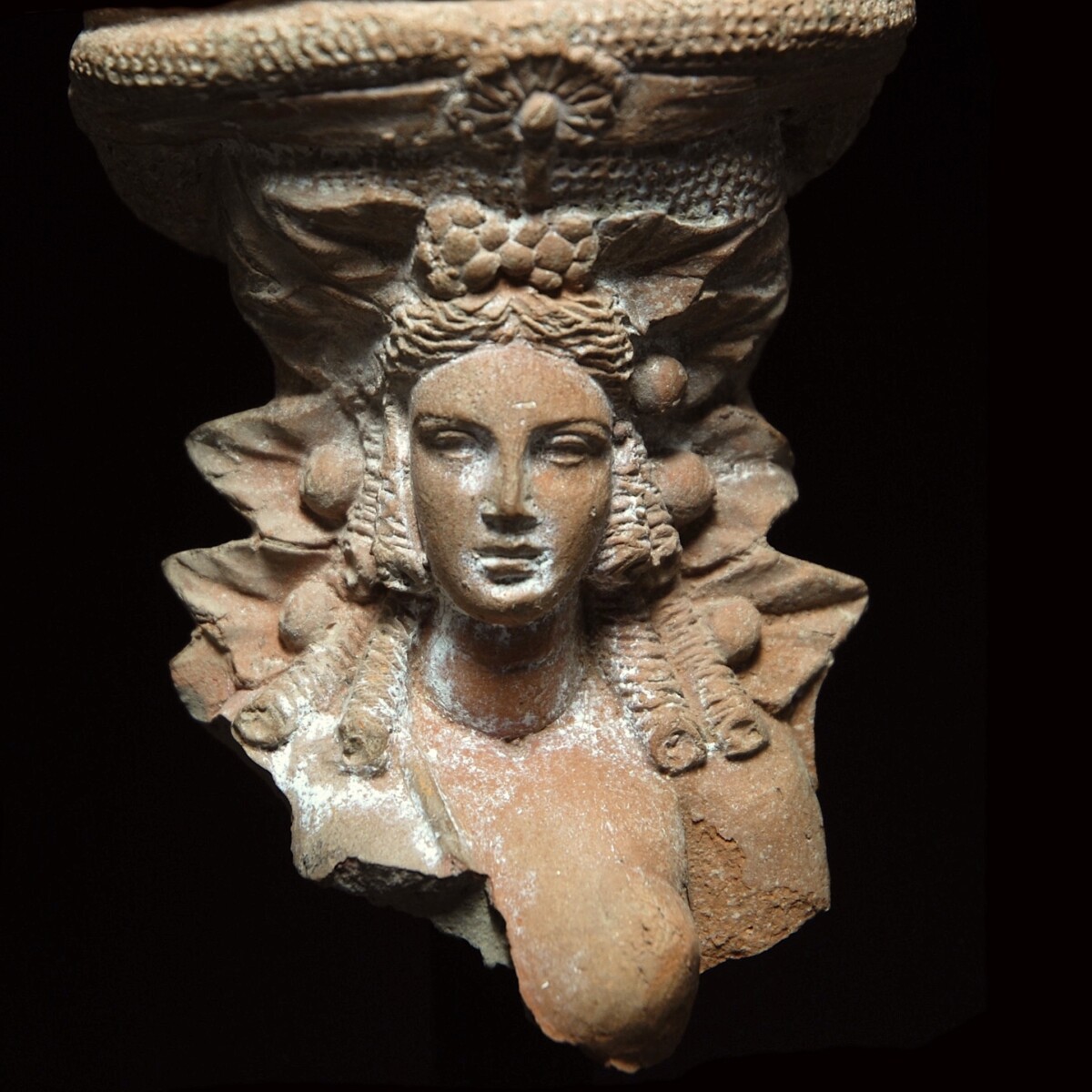
|
|
|
|
|
|
Egypt – Ptolemaic period, around 300-30 B.C.
|
Fragment of a large terracotta statue of Isis-Aphrodite. The very graceful depiction of the syncretic deity with noble features, full lips and a straight nose. The hair cascades in four long corkscrew curls to her shoulder, shorter curls cover the ears. The face and neck with Venus wrinkle are framed by leaves and fruits. The bare left breast is still preserved. Isis-Aphrodite wears her typical, opulent headdress with a central rosette on an encircling diadem. Above a high rising feather crown with a sun disk. Isis-Aphrodite is a Ptolemaic-era syncretic deity of the great Isis associated with the fertility aspect of Aphrodite. She represents marriage and birth and, following the old pharaonic model, also for rebirth. Elaborate accessories, amongst them her enormous kalathos on her head (the crown of Egyptian-Greek-Roman deities), which is always abundantly decorated, underline her impact. Mounted.
|
Provenance: French private collection Madame D. for at least 45 years. Last in a court-ordered auction of the private collection of Madame D.
Dimensions: 16.2 cm high
Price: 4 000 Euro
|
|
|
|
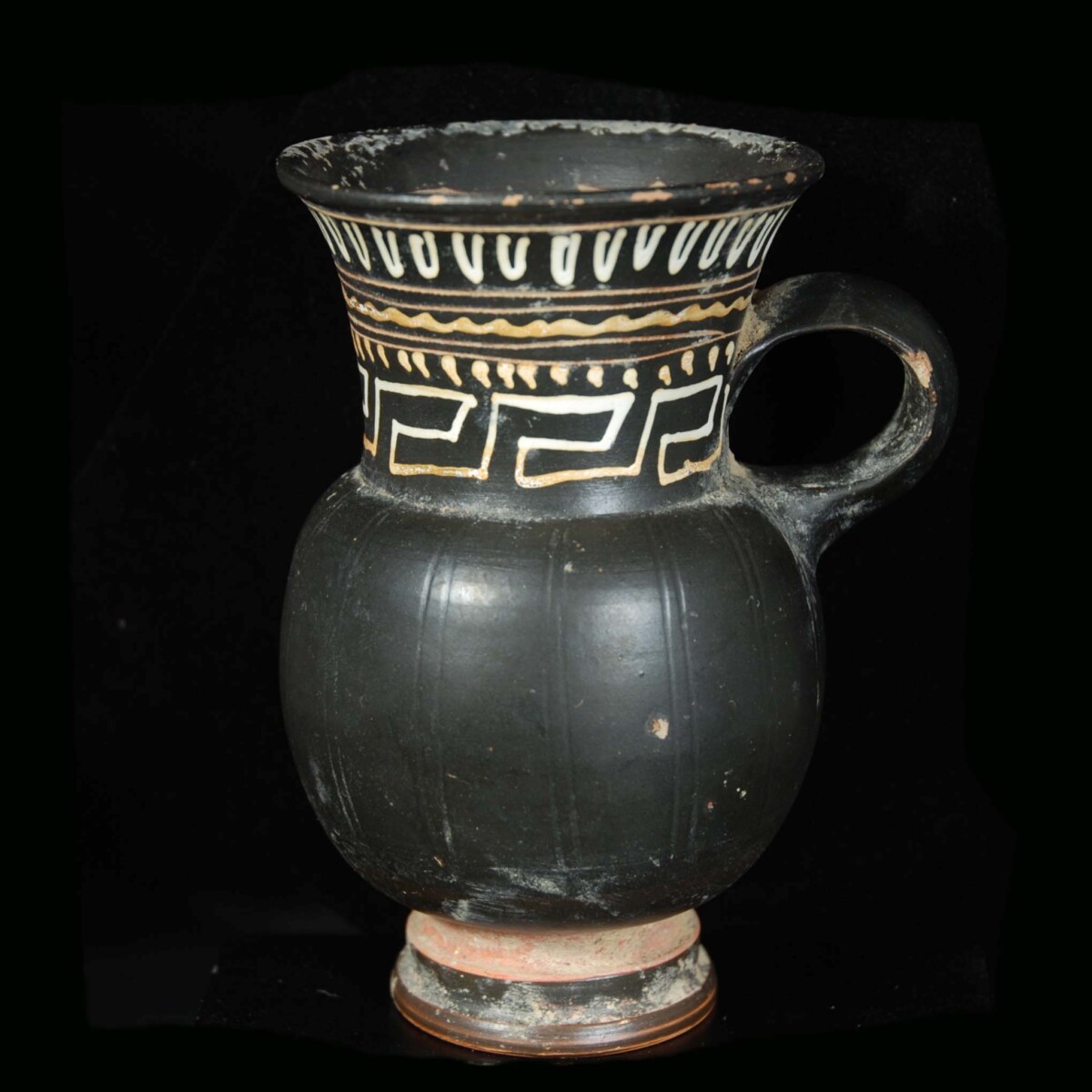
|
|
|
|
Greece/Gnathia – 2nd half of 4th century B.C.
|
Finely worked out, black glazed jug with yellow and white paint. The bulbous corpus with vertical double ribs stands on a profiled, slightly set off ring foot. The neck with white meanders, above grapes, bands and incised lines. Below the rim white tongue decoration between encircling incised lines. The circular handle starts at the neck and ends on the shoulder. The funnel-shaped rim is pulled outwards.
|
Provenance: German private collection H. W., acquired 1998 from the Strolz collection in Trier, Germany.
Dimensions: 11.9 cm high
Price: 600 Euro
|
|
|
|
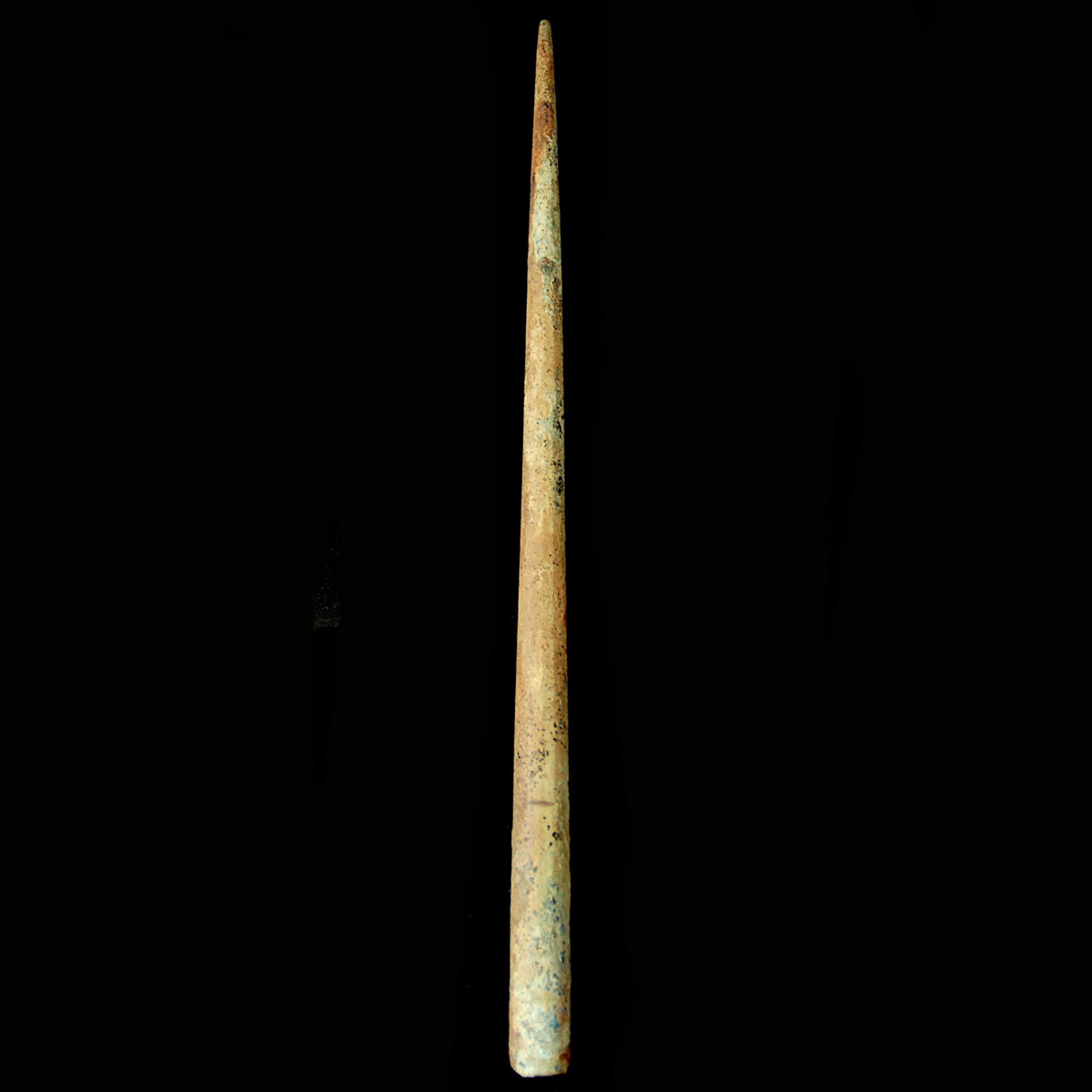
|
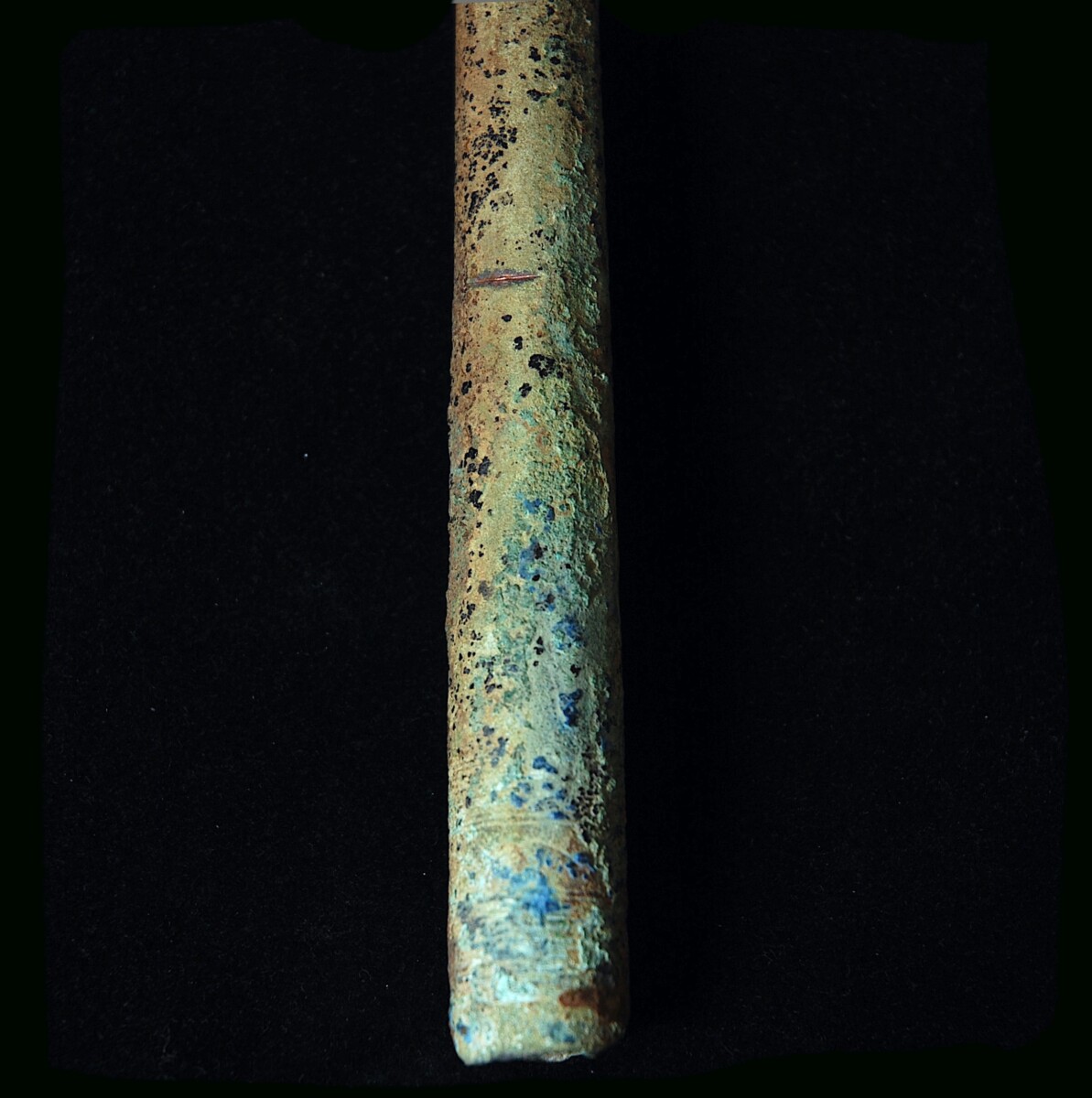
|
|
Etruria –7th century B.C.
|
Tapering, very long, bronze early Etruscan spear butt with a slightly square cross-section. The shaft of the spear butt with fine incised decorations. Very rare.
|
Provenance: From a German private collection, acquired between 1970 and 1990.
Dimensions: 37 cm long
Price: 850 Euro
|
|
|
|
|
|
|
|
Ein bunter Herbstreigen mit
Kunst der Antike
|
Nach einer außerordentlich erfolgreichen Sommermesse bei den Salzburger Festspielen, bei der wir uns erstmals wieder über eine große Zahl internationaler Besucher freuen durften, bereiten wir bereits die großen Herbst-Events vor. Zunächst werden wir als einzige Galerie für Kunst der Antike auf der ART AUSTRIA Highlights von 6. bis 9. Oktober in Wien ausstellen. Und nur kurz darauf, am Donnerstag, den 13. Oktober, eröffnen wir unsere große Herbstausstellung in unserem Showroom in Wien. Details und Einladungen folgen selbstverständlich. Nur eines vorweg: Die Götter werden in ihrer figürlichen Pracht wie Mars und anmutigen Schönheit wie Isis-Aphropdite stark vertreten sein.
|
|
|
|
Unser Highlight des Monats:
|
|
Römisches Reich – 2. Jahrhundert n. Chr.
|
Große und bedeutende Vollbronze-Statuette des Mars. Der Kriegsgott steht unbekleidet mit dem Gewicht auf seinem rechten Bein, das linke Spielbein leicht nach hinten abgewinkelt. Er trägt einen korinthischen Helm des süditalischen Typs mit hohem Helmbusch, der von einem Greifen gestützt wird und hinten in einer Volute endet. Der Wangenschutz ist nach oben geklappt, das dichte, halblange Haar quillt unter dem Helm hervor. Die heroischen Gesichtszüge und die in der Mitte gescheitelten Locken stehen noch in der Tradition Alexander des Großen. In seiner rechten, erhobenen Hand hielt er einen separat gearbeiteten Speer, der heute verloren ist. In der nach vorne abgewinkelten Linken hielt er ein am Unterarm aufgelegtes Schwert. Brustwarzen und Lippen sind mit Kupfer eingelegt, die Augen wohl in Silber. Vergleiche zum Typus die römische Bronze-Statuette des Mars im Louvre mit der Inventarnummer Br1045. Gesockelt.
|
Provenienz: Aus der Privatsammlung des französischen Archäologen Louis-Gabriel Bellon (1819-1899). Seit über 120 Jahren in Familienbesitz.
Höhe: 21,5 cm
Price: 32.000 Euro
|
|
|
|
Ausgewählte Kunstwerke des Monats:
|
|
Ägypten – 18. Dynastie, Amarna-Periode, 1351-1334 v. Chr.
|
Großes Kalkstein-Fragment aus der Amarna-Periode unter der Herrschaft des Pharaos Echnaton. Dargestellt sind zwei männliche Figuren, die sich zueinander beugen. Der rechte Mann trägt einen langen, glatten Kilt und stützt eine große Vase mit seinen überlangen Armen auf einem Dreifuß ab. Die linke Figur streckt ihre langen Arme ebenfalls in Richtung der Vase. Es ist wahrscheinlich, dass der rechte Mann (Echnaton selbst?) beim Verlassen eines Gebäudes gezeigt wird, nach einem Modell, das auch im Königsgrab von El-Amarna dokumentiert ist. Vergleiche zu dieser Annahme G. Thorndike Martin, "The Royal Tomb at El-'Amarna", London, 1989, Tafel 34. Die Gesichter mit den ellipsenförmigen Augen, den prägnanten Nasen und Kinns sind genauso typisch für die Kunst der Amarna-Periode wie die überlangen, schlanken Arme und Glieder. Gesockelt.
|
Provenienz: New Yorker Privatsammlung S. Carroll, erworben 1969. Danach Bonhams London vom 28. November 2017, Los 16.
Dimensionen: 23,5 cm x 38 cm
Preis: 28.000 Euro
|
|
|
|
|
Etrurien – 550-500 v. Chr.
|
Wunderbar erhaltenes Terrakotta-Antefix in Form eines archaischen Frauenkopfes mit schön erhaltener Bemalung. Die großen, mandelförmigen Augen mit rund gemalten Pupillen und sorgfältig gezogenen Brauen darüber. Der Mund ist zu dem typischen Lächeln geformt, die Nase vergleichsweise groß und lang. Das schwarz bemalte Haar fällt in gleichmäißgen Wellen in die Stirn, eine längere Strähne fällt jeweils vor den Ohren herab, zwei weitere dicke Strähnen reichen seitlich bis über den Hals. Die Frau trägt eine Halskette mit abwechselnd roten und schwarzen Perlen. Hinter dem Kopf ist auf einer Seite noch der lange Fortsatz erhalten, über den das Antefix im Gesims befestigt war. Wohl aus Cerveteri, dem antiken Caere.
|
Provenienz: Dem Vernehmen nach englische Privatsammlung vor 1970. Danach amerikanische Privatsammlung, erworben bei Faustus Ancient Art Ltd. in London im Jahr 1988. Danach Royal Athena Gallery New York, publiziert in: „Art oft the Ancient World“, Volume XXII, 2011, Nummer 93. Zuletzt in der Privatsammlung Sigrid Fiebig, Bad Herrenalb, erworben am 3. April 2016 in einer österreichischen Galerie. Mit Original-Rechnung und -Zertifikat von 2016.
Dimensionen: Höhe 17 cm; Tiefe 28,4 cm
Preis: 12.000 Euro
|
|
|
|
|
Ägypten – Dritte Zwischenzeit, 1069-945 v. Chr.
|
Große Statuette des zwergenhaften Schutzgottes Bes aus blau glasierter Fayence. Bes tritt hier in seiner Eigenschaft als Hüter und Nährer auf, als allmächtiger Herr über das Schicksal der Gebärenden und der Kinder. Er hockt auf einer Papyrussäule und trägt eine hohe Krone mit fünf Federn, die aus seiner korbähnlichem Kopfbedeckung, dem Kalathos, entwachsen. Die Enden der Federn sind schwarz gefärbt. Seitlich seines Kopfes und der abstehenden Ohren hocken zwei Affen, die ihre Vorderpfoten fressend zum Maul halten. Ein weiteres Affenjunge hält der Gott zärtlich in seiner linken Hand, während er diesem mit der rechten eine Frucht reicht. Ein viertes Affenjunge sitzt aufrecht ebenfalls fressend zwischen den kurzen, kräftigen Beinen des Bes. Das markante Gesicht des Schutzgottes ist typisch fratzenhaft, mit Zottelbart und geöffnetem Mund mit sichtbarer Zahnreihe und herausgestreckter Zunge. Die gesamte Figur ist auf der Vorder- und Rückseite mit schwarzen Linien und Punkten verziert. Lochungen am Ende der Federkrone und über den Ohren weisen darauf hin, dass die Statuette noch mit einem Edelmetall verziert war. Eine gerippte Öse an der Rückseite diente zur Aufhängung wohl am Bett oder im Zimmer einer Gebärenden oder deren Kinder. Die Unterseite ist ebenfalls gelocht, sodass die Statuette auch aufgestellt werden konnte. Gefunden im östlichen Delta. Publiziert in: „La Collection Emmacha. Antiquités Égyptiennes“, Livre 2, Paris 2013, Seiten 217-218. Vergleiche zum Typus die Figur im Penn Museum mit der Objektnummer E14358. Gesockelt.
|
Provenienz: Schweizer Kunsthandel vor 1983. Danach Sotheby’s New York am 8. Juni 1994, Los 10. Dort erworben von der Sammlung S., Paris. Danach Sammlung Emmacha Paris vor 2013. Mit Kopien der Publikation der Statuette aus dem Katalog der Sammlung Emmacha aus dem Jahr 2013. Mit französischem Antikenpass.
Höhe: 17,4 cm
Preis: 9.000 Euro
|
|
|
|
|
Sumer – Ur-III-Zeit, 2112-2004 v. Chr.
|
Große sumerische Keilschrift-Tafel, die auf beiden Seiten dicht und sorgfältig beschrieben ist. Die Tafel, die auf einer Seite flach, auf der anderen konvex gewölbt ist, gehört zu den sogenannten „Messenger Texts“. Diese Texttafeln nennen die Namen von Boten, die zwischen Mesopotamien und dem Iran hin- und herreisten und listen konkret auf, welche Speisen und Getränke den Boten in den Stationen entlang des Weges auszuhändigen sind. Die Boten bekommen dabei ihrem Rang entsprechend eine gewisse Anzahl Liter Bier und Brote, Öle sowie Zwiebel. Ist der Bote von adeligem Rang und reist in diplomatischer Mission erhält er ein Vielfaches an Proviant von herkömmlichen Boten. Vergleiche zu den Botentexten die Sammlung im Kelsey Museum of Archaeology an der Universität von Michigan in den USA. Siehe dazu: Nicole Brisch „A Sumerian Messenger Text in the Kelsey Museum“, Volume 15, 2003. Die meisten dieser Keilschrift-Tafeln, wie auch unsere, stammen aus den Städten Girsu und Umma, beide im Süden des heutigen Irak und auf der Reiseroute nach Iran. Unsere Keilschrift-Tafel mit Botentext ist verhältnismäßig groß und listet zahlreiche Namen auf. Bisher unveröffentlicht.
|
Provenienz: Aus der Sammlung des britischen Professors Geoffrey Wilson (1930-2015), erworben in den 1960er Jahren. Danach in einer Londoner Galerie. Zuletzt in der Sammlung Dr. D. G., erworben zwischen 1990 und 2019.
Dimensionen: 10 cm x 6,4 cm
Preis: 4.400 Euro
|
|
|
|
|
Griechenland – 7.-6. Jahrhundert v. Chr.
|
Ein zusammengehöriges Set von Goldblechen, die auf Augen und Mund eines verstorbenen Kriegers von hoher Stellung gelegt wurden. Die Augen aus fein gearbeitetem Goldblech, die über einen Nasenbügel miteinander verbunden sind. Die große Iris mandelförmig, außen umlaufend ein Rand aus punzierten Punkten. Der zugehörige Mund ebenfalls aus dünnem Goldblech und blattförmig. Der Rand aus punzierten Punkten. Durch die Mitte eine fein gezogene Linie zwischen Ober- und Unterlippe. In einem schwarzen Rahmen hinter Glas zur Aufhängung an der Wand oder zum Aufstellen auf einem Möbel montiert.
|
Provenienz: Aus der bayerischen Sammlung W. M., erworben in den 1990er Jahren auf der Numismata in München.
Länge Augenpaar: 11,8 cm; Länge Mund: 6,5 cm; Dimension Rahmen: 25,5 cm x 25,5 cm
Preis: 1.600 Euro
|
|
|
|
|
Kaukasus – 1200-900 v. Chr.
|
Große und schwere Bronze-Statuette eines aufrecht stehenden Ebers. Das Tier mit geraden Vorderläufen und leicht durchgebogenen Hinterläufen. Das Gesäß mit dem kurzen, aufgestellten Schwänzchen ist nach hinten gepresst. Der massige Körper mit nach unten durchhängendem Bauch. Der Kopf sitzt auf einem kräftigen Hals, die Ohren sind aufgestellt, der Rüssel gerade nach vorne ausgerichtet. Am Rücken des Tieres eine große Öse zur Aufhängung. Auf Grund des Gewichts (103 Gramm) darf auch spekuliert werden, dass der Eber nicht als Amulett, sondern als Gewicht diente.
|
Provenienz: Privatsammlung Robert Blanchet (1921-2009), erworben am 11. April 1997 in der Galerie Jean Philippe Mariaud de Serres in Paris. Seitdem in Familienbesitz. Mit Original-Sammlungskarte und handschriftlicher Beschreibung des Sammlers sowie dem Original-Zertifikat der Galerie de Serres.
Dimensionen: 6,1 cm x 6,6 cm
Preis: 4.400 Euro
|
|
|
|
|
Griechenland – 2.-1. Jahrhundert v. Chr.
|
Linker Teil einer Marmor-Votivstele, die eine Begräbnisprozession zeigt. Links eine Frau mit Blick nach rechts. Sie trägt ein langes Gewand und hat einen Umhang um den rechten Arm geworfen. Sie hat das Haar in der Mitte gescheitelt und hinten zu einem Knoten gebunden. Ihr zugewandt steht ein Mann hohen Ranges mit einem Bürgerstab. Er hält in der rechten Hand eine Opferschale. Rechts von ihm wendet sich ein Knabe einem Opfertisch zu. In der Hand hält er wohl eine Pyxis. Hinter dem Tisch sitzt der oder die Verstorbene, die rechte Hand ist den opfernden Teilnehmern der Prozession entgegengestreckt.
|
Provenienz: Nicolas Koutoulakis (1910-1996), Paris und Genf. Seitdem in Familienbesitz.
Höhe: 37 cm
Preis: 6.600 Euro
|
|
|
|
|
Griechenland/Süditalien – um 700 v. Chr.
|
Wunderbar erhaltener Terrakotta-Krug mit zylindrischem Korpus und flacher Basis. Der Rand ist leicht nach außen gebogen und mit rotbrauner Farbe bemalt. Der gesamte Korpus ist umlaufend geometrischen Ornamenten in fünf Registern verziert. Darunter unterschiedliche große Mäander, Rechtecke und Wellenlinien. Zwischen den Registern umlaufende, dunkelbraune Bänder. Besonders auffällig ist der achterförmig geschwungene Bandhenkel mit Daumenauflage. Diese Daumenauflage ist mit einem stilisierten Tier, wohl einem Vogel verziert. Die Außenseite des Bandhenkels mit aufgemalten Pfeilen. Aus Süditalien. In dieser Form selten.
|
Provenienz: Amerikanische Privatsammlung, versteigert in einem Auktionshaus in Chicago am 2. April 2003, Los 637.
Höhe: 14 cm
Preis: 1.800 Euro
|
|
|
|
|
Ägypten – Ptolemäische Zeit, etwa 300-30 v. Chr.
|
Fragment einer großen Terrakotta-Statue der Isis-Aphrodite. Die überaus anmutige Darstellung der synkretisierten Gottheit mit edlen Gesichtszügen, vollen Lippen und einer geraden Nase. Das Haar fällt der Göttin in vier langen Korkenzieherlocken bis auf die Schulter, kürzere Locken bedecken die Ohren. Das Gesicht und der Hals mit Venusfalte werden von Blättern und Früchten gerahmt. Die freiliegende linke Brust ist noch erhalten. Isis-Aphrodite trägt den für sie typischen, opulenten Kopfschmuck mit zentraler Rosette auf einem umlaufenden Diadem. Darüber eine hoch aufragende Federkrone mit Sonnenscheibe. Isis-Aphrodite ist eine in ptolemäischer Zeit aufkommende synkretisierte Gottheit der großen Isis, die mit dem Fruchtbarkeitsaspekt der Aphrodite verbunden ist. Sie steht für Ehe und Geburt und nach dem alten pharaonischen Vorbild auch für Wiedergeburt. Aufwändige Accessoires, darunter ihr gewaltiger Kalathos am Haupt (die Krone ägyptisch-griechisch-römischer Gottheiten), der stets reich geschmückt ist, verstärken ihre Wirkung. Gesockelt.
|
Provenienz: Französische Privatsammlung Madame D. seit zumindest 45 Jahren. Zuletzt in einer gerichtlich angeordneten Versteigerung der Privatsammlung Madame D.
Höhe: 16,2 cm
Preis: 4.000 Euro
|
|
|
|
|
Griechenland/Gnathia – 2. Hälfte 4. Jahrhundert v. Chr.
|
Fein gearbeitete, schwarz glasierte Kanne mit gelber und weißer Bemalung. Der bauchige Korpus mit vertikalen Doppelrippen steht auf einem profilierten, leicht abgesetzten Ringfuß. Der Hals mit weißem Mäander, darüber Trauben, Bänder und Ritzlinien. Unter dem Rand weißes Zungendekor zwischen umlaufenden Ritzlinien. Der kreisförmige Henkel setzt am Hals an und endet auf der Schulter. Der Rand trichterförmig nach außen gewölbt.
|
Provenienz: Deutsche Privatsammlung H. W., erworben 1998 aus der Sammlung Strolz in Trier.
Höhe: 11,9 cm
Preis: 400 Euro
|
|
|
|
|
Etrurien – 7. Jahrhundert v. Chr.
|
Spitz zulaufender, sehr langer frühetruskischer Lanzenschuh aus Bronze mit leicht eckigem Querschnitt. Der Schaft des Lanzenschuhs mit feinen Riefelungen. Sehr selten.
|
Provenienz: Aus deutscher Privatsammlung, erworben zwischen 1970 und 1990.
Länge: 37 cm
Preis: 850 Euro
|
|
|
|
|
|
|
CHRISTOPH BACHER ARCHÄOLOGIE ANCIENT ART GmbH
|
Galerie: Stubenring 20, A-1010 Wien
Showroom: Untere Viaduktgasse 55, A-1030 Wien
|
|
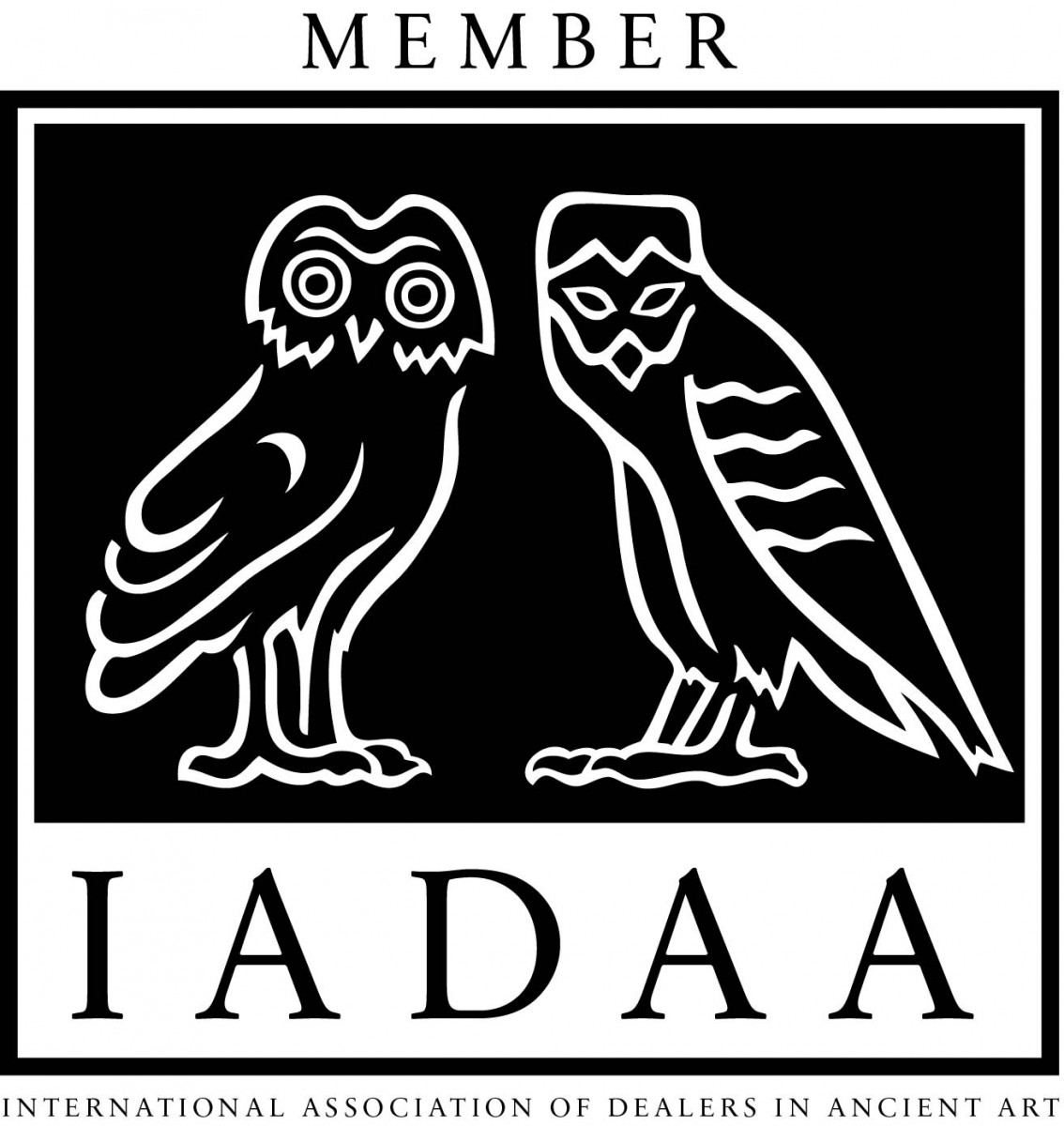
|
|
|
|